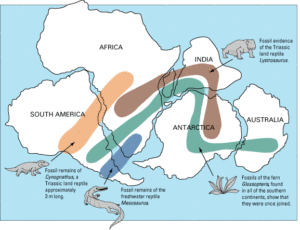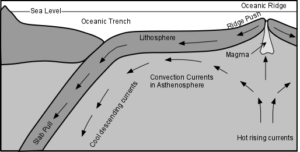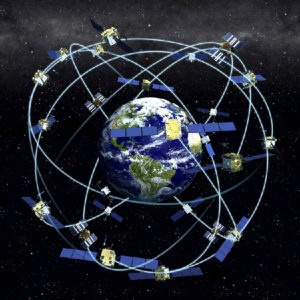Part 1: Life on a Young Earth
There it was, written right at the top of the completed homework assignment. The words leapt out at me as though emblazoned in the form of a neon sign –Not True. I recall staring at my student’s handwritten comment in a state of bewilderment. Had I been unclear in my presentation of the material? Was the concept too difficult for students to understand? Was the time spent developing and presenting this lesson wasted? What on earth would prompt such a blatant rejection of facts from a pupil?
You might venture to guess that the homework assignment dealt with some esoteric, highly hypothetical subject like the possibility of multiple universes or the impending fate of the cosmos. In this case, you would be mistaken. The concept upon which the assignment was based is one of the most well established in science – the plate tectonics theory. But why would this otherwise excellent student write such a comment on his paper I wondered? This was a statement that showed a total rejection of the fruits of several decades of progress in geology. It was a complete denial of what science has revealed about the geological dynamics of planet earth. And then it dawned on me. The assignment we had just completed (and by extension, the plate tectonics theory) showed that the earth is extraordinarily old.
This young man’s worldview was heavily influenced by the church he attended. As you may guess, the earth upon which this congregation lived was only six thousand years old. Was my student rejecting the theory itself or were they denying evidence that the earth is incredibly ancient? A sensation I can only describe as despondency crept over me. Was it really necessary for this young person to steadfastly choose between science and belief?
In analyzing this example of science rejection, we need to take a quick look at the plate tectonics theory itself. Is it so tenuous that it deserves the distrust bestowed upon it by my student? Then in the second installment of this essay, I will suggest a rationale for his belief in a young earth. I suggest that it is based upon an explicit religious belief which is misguided, misunderstood, and unnecessary.
There are two major ideas encompassed by the plate tectonics theory. The first involves the structure of the earth’s crust. The crust is the outer layer  of the earth. It is the part upon which we live, hike, climb, and run. We might think of earth’s crust as the skin of a fruit or the shell of an egg. The important point, in regards to plate tectonics, is that scientists have found that the crust is fractured into pieces of various sizes. These are the so-called tectonic plates. The second grand notion within the theory is that these tectonic plates are in motion (you may have heard of the term continental drift). What geologists now recognize is that the tectonic plates into which the crust is fractured include not just continents but adjacent portions of seafloor as well. In fact one of the largest plates, the Pacific plate, is almost entirely seafloor. Here in Indiana we are passengers, leisurely riding to the southwest, on the North American plate. This plate also includes most of the floor of the western Atlantic. Granted, it is rather difficult to imagine the continents and seafloors wandering about over the surface of the globe. The notion is not something that is intuitive and I personally heard skepticism being voiced as late as the 1970’s.
of the earth. It is the part upon which we live, hike, climb, and run. We might think of earth’s crust as the skin of a fruit or the shell of an egg. The important point, in regards to plate tectonics, is that scientists have found that the crust is fractured into pieces of various sizes. These are the so-called tectonic plates. The second grand notion within the theory is that these tectonic plates are in motion (you may have heard of the term continental drift). What geologists now recognize is that the tectonic plates into which the crust is fractured include not just continents but adjacent portions of seafloor as well. In fact one of the largest plates, the Pacific plate, is almost entirely seafloor. Here in Indiana we are passengers, leisurely riding to the southwest, on the North American plate. This plate also includes most of the floor of the western Atlantic. Granted, it is rather difficult to imagine the continents and seafloors wandering about over the surface of the globe. The notion is not something that is intuitive and I personally heard skepticism being voiced as late as the 1970’s.
Looking at a world map, one is likely to notice that the contours of the eastern coastline of South American and the western coast of Africa could juxtapose like pieces of a puzzle. This apposition has been perceived over the years by a number of scientists. However, the person most often associated with the original proposal that these two continents were once joined together is the German geophysicist Alfred Wegener (1880-1930). In 1915 Wegener suggested that the earth’s continents had once been united as a single enormous land mass he called Pangaea. Unfortunately he had little evidence to support his hypothesis of “continental drift.”
Over time, evidence that the continents were once united came to light. Certain kinds of plant and animal fossils were found in widely differing  locals upon earth. Fossils of the ancient plant Glossopteris, for example, are found in South America, South Africa, Australia, and India. Certain types of bedrock and fossils occur in both eastern North America and Western Europe. Fossils of the ancient mammal-like reptile Lystrosaurus have been found in Africa, Europe, Asia, South America, Australia, and even Antarctica. Such biogeography suggests that these organisms once inhabited the same land mass. Alternatively, some scientists postulated that ancient land bridges between the continents could explain such disjunct fossil distribution. However, with certain exceptions, no evidence of such bridges is known to exist.
locals upon earth. Fossils of the ancient plant Glossopteris, for example, are found in South America, South Africa, Australia, and India. Certain types of bedrock and fossils occur in both eastern North America and Western Europe. Fossils of the ancient mammal-like reptile Lystrosaurus have been found in Africa, Europe, Asia, South America, Australia, and even Antarctica. Such biogeography suggests that these organisms once inhabited the same land mass. Alternatively, some scientists postulated that ancient land bridges between the continents could explain such disjunct fossil distribution. However, with certain exceptions, no evidence of such bridges is known to exist.
Then, in the 1950’s, scientists found confirmation of a mid-ocean ridge running between the Americas, Europe, and Africa. This ridge was highly geologically active with frequent earthquakes and magma extrusions. It came to be understood that such ridges were common at many other places under the world’s oceans. Not only that, it was soon realized that they  marked the boundaries of the planet’s tectonic plates. From this knowledge came the concept of sea floor spreading. At these ridges, molten rock wells up from deep within the earth. As it does so, tectonic plates are pushed apart as new seafloor is built. Several years after his death, geologists had begun to understand the mechanism which could actually cause Wegener’s “continental drift” to occur.
marked the boundaries of the planet’s tectonic plates. From this knowledge came the concept of sea floor spreading. At these ridges, molten rock wells up from deep within the earth. As it does so, tectonic plates are pushed apart as new seafloor is built. Several years after his death, geologists had begun to understand the mechanism which could actually cause Wegener’s “continental drift” to occur.
As more and more information about the earth’s interior was gathered over the ensuing decades, it became clearer how tectonic plate movement was caused. Scientists have known for some time that the earth’s crust rests upon an underlying layer of exceedingly dense, hot rock some eighteen-hundred miles thick. This zone, which lies between earth’s crust and outer core, is called the mantle. Unlike the hard, brittle crustal rock with which we are familiar, the rock of the mantle is molten and behaves like a plastic – it flows. Convection currents form within the mantle. Hot mantle material rises up toward the crust, cools and descends back into the depths. These circulating motions provide the forces which move the tectonic plates.
At some points, like the mid-Atlantic ridge, the tectonic plates are being pushed apart. At other places the plates slide past one another. As these plates grind against each other they may, like passengers entering and exiting a crowded subway car, become stuck one against the other. Immense frictional forces build until, with a sudden lurch, they begin moving again. The enormous stored energy is released as an earthquake as the crust harmonically oscillates in elastic rebound. The San Andreas Fault in California is a classic example.
The Indian subcontinent, part of the Indo-Australian plate, is plowing into Asia even now. Like the crumpling of a fender in an auto collision, the pile-up has raised the immense Himalayas. Of course if tectonic plates are moving apart at various places on the globe, they have to be disappearing in others. The earth isn’t expanding like some gargantuan balloon.
Off the west coast of the United States and Canada, along the west coast of South America, and near the coasts of Japan and Indonesia lie so-called  subduction zones. Here material from one tectonic plate dives beneath another plate and is reincorporated into the mantle. These are zones of tremendous geological activity, highly prone to earthquake and volcanic activity. Once these regions of plate movement were identified, and their causal mechanisms understood, it became quite clear as to why certain regions of the world were extremely prone to earthquakes, volcanic activity, and tsunamis.
subduction zones. Here material from one tectonic plate dives beneath another plate and is reincorporated into the mantle. These are zones of tremendous geological activity, highly prone to earthquake and volcanic activity. Once these regions of plate movement were identified, and their causal mechanisms understood, it became quite clear as to why certain regions of the world were extremely prone to earthquakes, volcanic activity, and tsunamis.
You may wonder, with so much evidence at hand, what the exercise to which my student so adamantly objected entailed. In fact, the classwork we were completing simply dealt with one more undeniable piece of evidence for the ploddingly slow movement of tectonic plates. The motion of these plates was originally detected by ancillary geological sleuthing. Suggestive data were obtained by measuring the relative age of sea floor rocks at increasingly greater distances away from the mid-Atlantic ridge. As one proceeds farther from this mid-ocean ridge, the bedrock of the seafloor becomes progressively older. This is precisely what we would expect if new seafloor was being formed as lava was extruded from this rift and was pushing the North American and Eurasian plates apart.
However, our classroom exercise dealt with an even more direct means of observing plate movement. In fact, using this method, geologists can actually measure the rate at which plates move. If you use a GPS unit while driving, hiking, flying, or boating then I assume you are confident in its  functionality. As you may know, your GPS unit depends on information gleaned from a system of many satellites (the Global Positioning System) that orbit several thousand miles above the earth. Just as these satellites can measure your speed as you zip along an Interstate, they can also detect and quantify the rate at which tectonic plates are moving in relationship to one another.
functionality. As you may know, your GPS unit depends on information gleaned from a system of many satellites (the Global Positioning System) that orbit several thousand miles above the earth. Just as these satellites can measure your speed as you zip along an Interstate, they can also detect and quantify the rate at which tectonic plates are moving in relationship to one another.
From such satellite technology, it has been determined that North America and Europe are moving away from each other at a little less than an inch per year. This speed is commonly compared to the rate at which our fingernails grow. Taking the average width of the Atlantic Ocean to be twenty-five hundred miles, and assuming a constant rate of sea floor spreading, I had asked the students to calculate the Atlantic’s age. If one does the appropriate calculations, an estimated age of around two-hundred million years will be attained. This coincides rather closely with the estimated span of time since the supercontinent Pangaea began to break apart.
It may well be that my incredulous student accepted the reality of tectonic plate movement. The issue for him could have been the rate at which the movement occurred. Some young earth proponents subscribe to an idea known as catastrophic plate tectonics. This notion proposes movement of the tectonic plates at a speed of many meters per second. They reason that plate movements and the breakup of a super continent (if one even existed) could occur within a few thousand years. Observed geological evidence, such as the aforementioned satellite data, does not support such high velocity plate movement. As another example, the formation of archipelagos, such as the Hawaiian Islands, clearly demonstrate slow, long term crustal movement over a tectonic hot spot. Thus I was puzzled greatly.
Why did it make sense to reject data on the rate of plate movement garnered through satellite monitoring, a technology of extreme commonality now? This rejection was particularly mystifying to me because I suspected that my recalcitrant student would feel no hesitation in making personal use of this same technology. Making sure he was taking the quickest route to another state for example. Then again, I wondered, did contemplating the possibility of an ancient earth seem far too threatening to his religious beliefs to even consider. Did he imagine that accepting one piece of geologic science would put him on the slippery slope to accepting other scientific theories? If so, perhaps he saw in this lesson a dangerous threat to scriptural authority. He certainly would not have been the first person dig in their heels when belief is threatened by fact.
Stay tuned. In my next blog (No. 36: Not True), I hope to illuminate how the belief in a 6000 year old earth became dogma among certain practitioners of the Christian religion. I will also contend that this misguided conviction is a hindrance to the development of a belief system compatible with what we have learned from science in the past five millennia.
Photo Credits: earth in cross section - Oregon St. Univ. @ commons.wikimedia.org biogeography Pangea - cimss.ssec.wisc.edu @ commons.wikimedia.org mid-Atlantic ridge - NOAA @ commons.wikimedia.org tectonic plate movement - Tulane.edu.sanelson @ commons.wikimedia.org GPS costellation - spaceplace.nasa.gov
